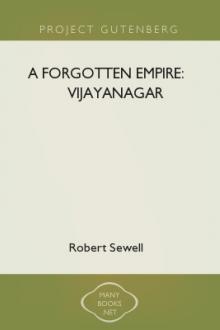A Forgotten Empire: Vijayanagar by Robert Sewell (short story to read TXT) 📕

- Author: Robert Sewell
- Performer: -
Book online «A Forgotten Empire: Vijayanagar by Robert Sewell (short story to read TXT) 📕». Author Robert Sewell
His minister was one of the powerful Saluva family, to which also had belonged Timma, the minister of King Krishna. Nuniz calls him “Salvanay.” The earliest known date of Achyuta’s reign is gathered from an inscription bearing a date corresponding to Monday, August 15, A.D. 1530.[264]
The beginning of his reign was ominously signalised by the loss of the frontier fortresses Mudkal and Raichur. Firishtah265 states that the Adil Shah had, some time before the death of Krishna Deva, made preparations to recover possession of these cities, and proceeds: —
“The Sultan … put his army in motion, attended by Ummad Shaw and Ameer Bereed with their forces; and the affairs of Beejanuggur being in confusion owing to the death of Heemraaje, who was newly succeeded by his son Ramraaje,[266] against whom rebellions had arisen by several roles, met with no interruptions to his arms. Roijore and Mudkul were taken, after a siege of three months, by capitulation, after they had been in possession of the infidels for seventeen years.”[267]
The relief and delight of the Adil Shah at these successes, and at the death of his mortal enemy Krishna, must have been great; and Firishtah relates that the Sultan, “who had vowed to refrain from wine till the reduction of these fortresses, at the request of his nobility now made a splendid festival, at which he drank wine and gave a full loose to mirth and pleasure.” Raichur and Mudkal were never again subject to Hindu princes.
Those who desire to obtain an insight into the character of the new king of Vijayanagar should turn to the chronicle of Nuniz. It will suffice here to say that he alienated his best friends by his violent despotism, and at the same time proved to the whole empire that he was a coward. His conduct and mode of government ruined the Hindu cause in Southern India and opened the whole country to the invader, though he himself did not live to see the end.
After the fall of Raichur and the Doab, Ismail Adil had another fight (1531) with his rival at Ahmadnagar and defeated him; after which the two brothers-in-law consolidated a strong alliance. Three years later Ismail died, having contracted a fever while besieging a fortress belonging to the Qutb Shah of Golkonda. His death occurred on Thursday, August 13, 1534,[268] and he was succeeded by his son Malu. Asada Khan was appointed regent of Bijapur, but immediately on his accession the new sovereign so offended his powerful subject that he retired to Belgaum, and Sultan Malu, giving himself up to all kinds of excesses, was deposed after a reign of only six months. Malu was blinded by the orders of his own grandmother, and Ibrahim Adil, his younger brother, was raised to the throne. It was now 1535.
Da Cunha, the Portuguese governor of Goa, took advantage of these events to erect a fortress at Diu, and early in 1536 to seize again the mainlands of Goa, which had been for ten years in the possession of Asada Khan. The Khan sent a force to recapture these lands, and in February an engagement took place in which the Portuguese were victorious. A second attack by the Moslems was similarly repulsed. A third fight took place in July, and again the Muhammadans were beaten; but Asada Khan then assembled a larger army, and the foreigners were compelled to retire after blowing up their fortress.
About this time269 Quli Qutb Shah is said to have attacked Kondavid on account of its withholding payment of tribute, to have taken it, and built a tower in the middle of the fort in commemoration of its reduction.
Two inscriptions at Conjeeveram, dated respectively in 1532 and 1533,[270] imply that at that period King Achyuta reduced the country about Tinnevelly; but apparently he was not present in person, and nothing further is known regarding this expedition.
We now enter upon a period very difficult to deal with satisfactorily, owing to the conflict of evidence in the works of the various writers.
“A year after his accession,” writes Firishtah,[271] “Ibrahim, Adil led his army to Beejanuggur on the requisition of the roy.” This would be the year 1536 A.D. But what led to such an extraordinary complication of affairs? Can it be true that King Achyuta was so humiliated and hard pressed as to be compelled to summon to his aid the hereditary enemies of his country?
Nuniz is silent as to the cause, though he admits the fact. It is quite possible that Firishtah is correct, that the public were not taken into confidence by their despotic rulers, and that the troops of Bijapur marched to the Hindu capital at the request of King Achyuta. That they actually came there seems quite certain, and it is probable that Nuniz was in Vijayanagar at the time; but there is a LACUNA in his story which can only be filled up by reference to Firishtah. Accepting Firishtah, we can readily understand why King Achyuta received the Sultan and his army without open opposition, as Nuniz declares that he did, and why the Muhammadan king received splendid presents before he retired. To Nuniz, however, this conduct was inexplicable except on the basis of Achyuta’s craven spirit and utter unworthiness.[272] As to the assertion of Nuniz that the Sultan entered Nagalapur or Hospett and “razed it to the ground,” we may remember the treatment of the city of Bijapur by Krishna Deva Raya,[273] and surmise that the houses of the Vijayanagar suburbs may have been pulled to pieces by the Mussalman soldiery in search for firewood. However all this may be, my readers have before them the story as given by Nuniz in Chapter XX. of his chronicle, and the following is Firishtah’s account of the event.[274]
“Heem” Rajah, or, as Briggs renders the name, “Tim” Rajah — representing “Timma,” and referring doubtless to Saluva Timma, the great minister of Krishna Deva — had, forty years earlier, become DE FACTO ruler of Vijayanagar on the death of the two sons of a former king, “Seo” Raya. He had poisoned the infant son of the younger of these sons, and had thus succeeded in becoming head of the state. During these forty years he had been obeyed by all. On his death his son Rama Rajah became ruler. Rama’s marriage to “a daughter of the son of Seo” Raya275 had greatly added to his dignity and power, and he now tried to secure the throne for himself and his family. He was, however, compelled by the nobles to recognise as king an “infant of the female line,” whose person he committed to the care of the child’s uncle, “Hoje” Tirumala Raya,[276] a man of weak intellect if not absolutely insane. In five or six years Rama cut off by treachery most of the chiefs who opposed him.[277] He then marched on an expedition into Malabar, and afterwards moved against a powerful zamindar to the south of Vijayanagar, who held out for six months and in the end beat off the troops of Rama Raya. Vijayanagar was at that time governed by a slave whom Rama had raised to high rank, and this man, on being applied to by the minister to send supplies from the capital, was so amazed at the wealth which he saw in the royal treasury that he resolved to attempt to gain possession of it. He therefore released the child-king, obtained the co-operation of Hoje Tirumala, assumed the office of minister, and began to raise troops. “Several tributary roies, who were disgusted with Ramraaje, flew with speed to Beejanuggur to obey their lawful king; and in a short time thirty thousand horse and vast hosts of foot were assembled under his standard at the city.” Tirumala then had the slave-governor assassinated. Rama Rajah at once returned to the capital, but was unable at that juncture to assert his authority. Finding himself deserted by many of the nobles he concluded a treaty with his lawful sovereign, and retired to his own province, which by agreement he was allowed to retain as his own independent state. Tirumala shortly afterwards strangled the king and seized the throne. The nobles submitted, since he was of royal blood, and better, in their opinion, than Rama Rajah; but when afterwards they found themselves unable to endure his tyranny and oppression, they rebelled and invited Rama Rajah to return.
Tirumala then found himself in great straits, and sent ambassadors with large presents to Ibrahim Adil Shah, begging him to march to his assistance and promising that the Vijayanagar kingdom should be declared tributary to Bijapur. Ibrahim, delighted beyond measure, after consulting Asada Khan accepted the terms, moved from his capital, and arrived before Vijayanagar “in the year 942,” which corresponds to the period from July 2, A.D. 1535, to June 20, 1536.[278] He was conducted into the city by Hoje Termul Roy, who seated him on the musnud of the raaje and made rejoicings for seven days.” This conduct led to a change of front on the part of Rama Rajah and his supporters. They entreated Tirumala for the sake of the country to procure the retreat of the Sultan to his own dominions, promising submission and obedience if this should be done; and Tirumala, thinking that now he had no further use for his allies, requested the Sultan to return home. He paid over the subsidy agreed upon, which was assessed at something approaching two millions sterling, and made many other gifts. The story then ends with a tragedy.
“Ibrahim Adil Shaw had not yet recrossed the Kistnah, when Ramraaje and the confederates, who had bribed many of the troops in the city, broke their newly made vows, and hastened towards Beejanuggur, resolved to put the roy to death, on pretence of revenging the murder of his predecessor. Hoje Termul Roy, seeing he was betrayed, shut himself up in the palace, and, becoming mad from despair, blinded all the royal elephants and horses, also cutting off their tails, that they might be of no use to his enemy. All the diamonds, rubies, emeralds, other precious stones, and pearls, which had been collected in a course of many ages, he crushed to powder between heavy millstones, and scattered them on the ground. He then fixed a sword-blade into a pillar of his apartment, and ran his breast upon it with such force that it pierced through and came out at the back, thus putting an end to his existence, just as the gates of the palace were opened to his enemies. Ramraaje now became roy of Beejanuggur without a rival.”
After this point in Firishtah’s narrative we hear of no more “young Roies” or imprisoned sovereigns of the Second Dynasty. “Ramraaje” alone is spoken of as king, and Kings Achyuta and Sadasiva — the latter of whom was undoubtedly recognised as king for some years though he was kept in custody — are not so much as mentioned.
Thus Firishtah and Nuniz both agree that Ibrahim Adil advanced as far as the city of Vijayanagar, and retired after payment of immense sums of money and the gift of many valuable presents. The date was A.D. 1535 — 36. With this date ends the historical portion of the chronicle of Nuniz.[279]
We continue the narrative of events in Achyuta’s reign as gathered from Firishtah.[280] As soon as he heard of the death of Hoje Tirumala and the seizure of the throne by “Ramraaje,” Ibrahim Adil Shah sent Asada Khan to reduce the important fortress of Adoni, which was undisputedly in Vijayanagar territory. Rama Rajah despatched





Comments (0)